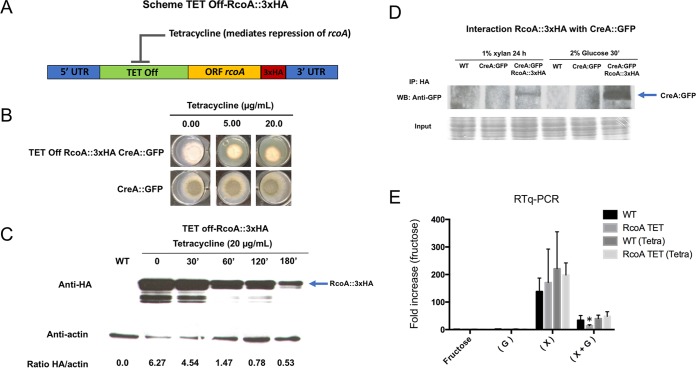FIG 6 .
RcoA physically interacts with CreA but is not required for CCR. (A) Diagram depicting the conditional mutant where rcoA is controlled by the TET off promoter and tagged with 3×HA in the CreA::GFP background strain. (B) Growth phenotypes of TET off-RcoA::3×HA CreA::GFP and CreA::GFP grown in MM without and with different tetracycline concentrations for 72 h at 37°C. (C) Western blot of TET off-RcoA::3×HA when grown in minimal medium supplemented with glucose for 24 h and after the addition of tetracycline (20 µg/ml) for 30, 60, 120, and 180 min. TET off-RcoA::3×HA was detected with anti-HA antibody (blue arrow), and protein content was normalized by sample actin content (HA/actin ratio). (D) Western blot of TET off-RcoA::3×HA CreA::GFP strain after immunoprecipitation (IP) of HA-tagged protein and incubation with anti-GFP antibody. Strains were grown for 24 h under xylan-rich conditions before glucose was added for 30 min. The wild-type (WT) and CreA::GFP strains were IP controls, whereas Coomassie blue straining of total protein before IP is indicated as the loading control. (E) RTq-PCR showing the expression of xlnA in the wild-type (WT) and TET off-RcoA::3×HA CreA::GFP strains when grown in MM supplemented with fructose (control, noninducing) for 24 h and after transfer to glucose-rich (G), xylose-rich (X), or glucose-rich and xylose-rich (X + G) conditions for 1 h. To ensure rcoA repression, 20 µg/ml tetracycline was added to the control cultures for a minimum of 3 h and after transfer to the different carbon sources.

